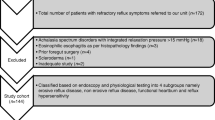Abstract
Esophageal pH monitoring in patients with gastroesophageal reflux symptoms identifies some who have normal esophageal acid exposure but nevertheless a convincing correlation between symptoms and those reflux events that do occur. These patients may exhibit enhanced sensory perception of physiological reflux. Little is known about the natural history of reflux symptoms in this group, which in our experience comprises up to 6% of those referred for diagnostic pH monitoring. We have therefore followed up by postal questionnaire 70 patients whose initial pH study had demonstrated normal acid exposure but a symptom index ≥50% and 58 patients found to have excess reflux, for a median of 4.4 and 6.5 years, respectively. The presenting character and frequency of symptoms and endoscopic and manometric findings were similar in the two groups. At review overall symptom frequency had improved (P<0.01) for both groups similarly. However, 87% of those with normal acid exposure and 79% of those with excess reflux remained symptomatic, 53% and 47%, respectively, recording their symptoms to be the same or worse than at original presentation, despite over 60% in each group continuing to take regular medication. Only six patients in each group were asymptomatic and receiving no therapy at the time of review. The results demonstrate that patients with symptomatic but not excess gastroesophageal reflux constitute a significant clinical problem. Both the persistence of their symptoms and their requirement for therapy are similar to that observed in “genuine” refluxers.
Similar content being viewed by others
References
Richter JE, Castell DO: Gastroesophageal reflux; pathogenesis, diagnosis and therapy. Ann Intern Med 97:93–103, 1982
Smout AJPM: Ambulatory monitoring of esophageal pH and pressure.In The Esophagus. DO Castell (ed). Boston, Little Brown, 1992, pp 161–177
Galmiche JP, Scarpignato C: Esophageal pH monitoring.In Functional Investigation in Esophageal Disease. Frontiers in Gastrointestinal Research, Vol 22. C. Scarpignato, JP Galmiche (eds). Basel, Karger, 1994, pp 71–108
Weiner GJ, Richter JE, Cooper JB, Wu WC, Castell DO: The symptom index: A clinically important parameter of ambulatory 24-hour esophageal pH monitoring. Am J Gastroenterol 83:358, 1988
Dent J, Dodds WJ, Friedman RH, et al: Mechanism of gastroesophageal reflux in recumbent asymptomatic human subjects. J Clin Invest 65:256–267, 1980
De Caestecker JS, Heading RC: Esophageal pH monitoring. Gastroenterol Clin North Am 19:645–669, 1990
Howard PJ, Pryde A, Heading RC: Relationship between gastroesophageal reflux and symptoms in patients referred for ambulatory pH-monitoring. J Gastrointest Motil 2:231–239, 1990
Johnston BT, McFarland RJ, Collins JSA, Love AHG: Symptom index as a marker of gastro-oesophageal reflux disease. Br J Surg 79:1054–1055, 1992
Singh S, Richter JE, Bradley LA, Haile JM: The symptom index: differential usefulness in suspected acid-related complaints of heartburn and chest pain. Dig Dis Sci 38:1402–1408, 1993
Richter JE, Baldi F, Clouse RE, Diamant NE, Janssens J, Staiano A: Functional oesophageal diseases. Gastroenterol Int 5:3–17, 1992
Murphy DW, Yuan Y, Castell DO: Does the intraesophageal pH probe accurately detect acid reflux? Simultaneous recording with two pH probes in humans. Dig Dis Sci 34:649–656, 1989
De Caestecker JS: 24 hour pH monitoring: advances and controversies. NJ Med 34:S20-S39, 1989
Benjamin SR, Richter JE, Cordova CM, Knuff TE, Castell DO: Prospective manometric evaluation with pharmacologic provocation of patients with suspected esophageal motility dysfunction. Gastroenterology 84:893–901, 1983
Howard PJ, Maher L, Pryde A, Heading RC: Symptomatic gastro-oesophageal reflux, abnormal oesophageal acid exposure, and mucosal acid sensitivity are three separate, though related, aspects of gastro-oesophageal reflux disease. Gut 32:128–132, 1991
Johnsson F, Joelsson B, Isberg PE: Ambulatory 24-hour intraoesophageal pH-monitoring in the diagnosis of gastrooesophageal reflux disease. Gut 28:1145, 1987
Sontag SJ: Rolling review: Gastro-oesophageal reflux disease. Ailment Pharmacol Ther 7:293–312, 1993
Spechler SJ: Barrett's esophagus: what's new and what to do. Am J Gastroenterol 84:220–223, 1989
Baldi F, Ferrarini F, Longanesi A, Ragazzini M, Barbara L: Acid gastroesophageal reflux and symptom occurrence: Analysis of some factors influencing their association. Dig Dis Sci 34:1890–1893, 1989
De Caestecker JS, Heading RC: The pathophysiology of reflux.In Reflux Oesophagitis. TPJ Hennessy, A Cuschier, JR Bennett (eds). London, Butterworth, 1989, pp 1–36
Trimble KC, Pryde A, Heading RC: Lowered oesophageal sensory thresholds in patients with symptomatic but not excess gastroesophageal reflux: Evidence for a spectrum of visceral sensitivity in GORD. Gut (in press)
Johnsson F, Joelsson B: Reproducibility of ambulatory oesophageal pH-monitoring. Gut 29:886–889, 1988
Weiner GJ, Morgan TM, Copper JB, Wu WC, Castell DO, Sinclair JW, Richter JE: Ambulatory 24-hour esophageal pH monitoring: Reproducibility and variability of pH parameters. Dig Dis Sci 33:1127–1133, 1988
Eriksen CA, Cushieri A: Diagnostic tests for gastrooesophageal reflux disease.In Reflux Oesophagitis. TPJ Hennessy, A Cuschieri, JR Bennett (eds). London, Butterworth 1989, pp 55–86
Pace F, Santalucia F, Bianchi Porro G: Natural history of gastro-oesophageal reflux disease without oesophagitis. Gut 32:845–848, 1991
Schindlbeck NE, Klauser AG, Berghammer G, Londong W, Mueller-Lissner SA: Three year follow-up of patients with gastroesophageal reflux disease. Gut 33:1016–1019, 1992
Kuster E, Ros E, Toledo-Pimentel V, Pujol A, Bordas JM, Grande L, Pera C: Predictive factors of the long term outcome in gastro-oesophageal reflux disease: Six year follow up of 107 patients. Gut 35:8–14, 1994
McDougall NI, Johnston BT, Kee F, Collins JSA, McFarland RJ, Watson RGP, Love AHG: The natural history of reflux oesophagitis: a ten year follow-up. Gut 35(suppl 2):T86, 1994 (Abstract)
Author information
Authors and Affiliations
Rights and permissions
About this article
Cite this article
Trimble, K.C., Douglas, S., Pryde, A. et al. Clinical characteristics and natural history of symptomatic but not excess gastroesophageal reflux. Digest Dis Sci 40, 1098–1104 (1995). https://doi.org/10.1007/BF02064206
Received:
Revised:
Accepted:
Issue Date:
DOI: https://doi.org/10.1007/BF02064206




